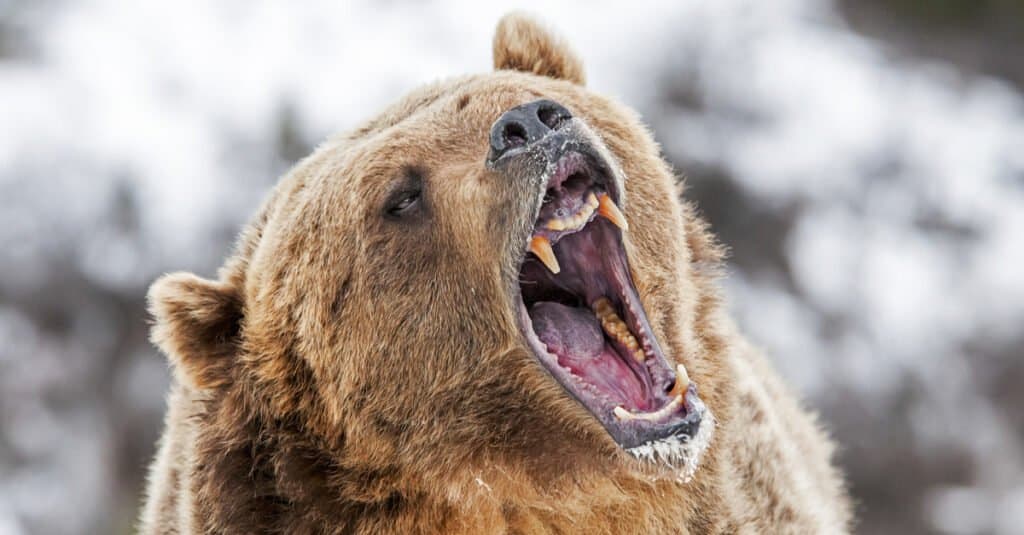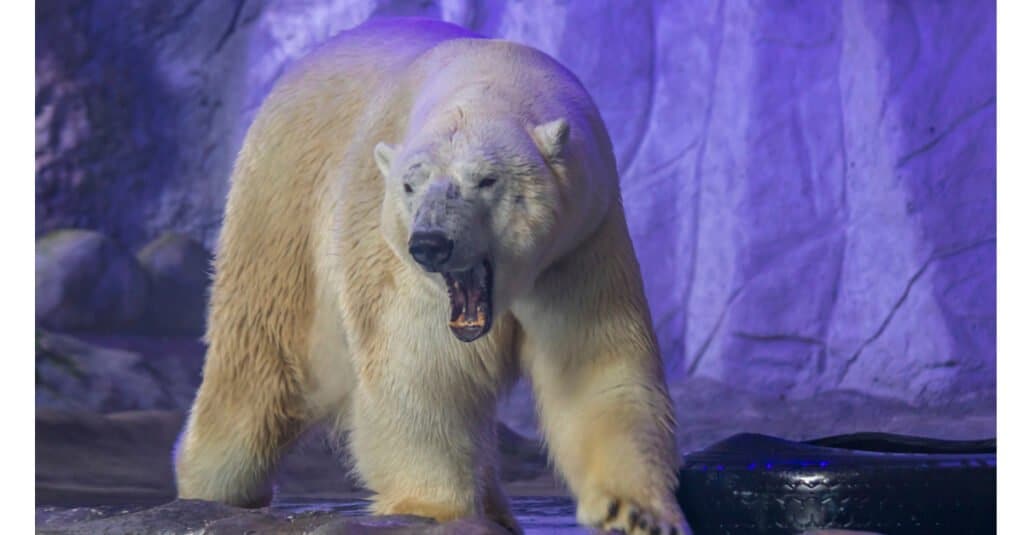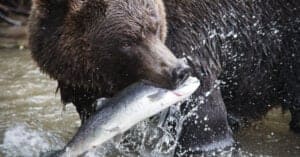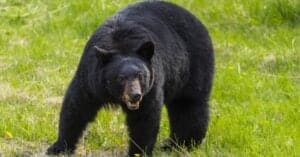Bear Teeth: Everything You Need to Know
They may be the usual models of cute and cuddly stuffed toys, but fully grown bears may not really be as cute and cuddly as their motionless counterparts. Bears have eight different species around the world, and they are one of the most massive mammals in whatever continent they are found in.
Each species of bear comes in different colors and sizes. The polar bear alone holds the title for the largest bear species, and can grow up to 10 feet tall, with the largest recorded polar bear weighing 2,209 pounds. Polar bears are the largest terrestrial carnivores on the planet and that is also reflected on their massive diet.
Bears look dangerous; especially when they let their teeth out! Relative to their massive size and weight, bears also have an extremely strong bite, making them a dangerous predator. Let’s dive into the teeth of bears and how they aid in feeding these massive animals!
What Kind of Teeth Do Bears Have?

Tony Campbell/Shutterstock.com
Like most mammals, bears are heterodonts, meaning they have a set of teeth that are combinations of different teeth types that each perform unique functions. Bears have incisors, canines, premolars, and molars that help them cut and chew meat while also allowing them to crush and grind plants and fruits.
Bears are mostly omnivorous, eating both plants and other animals. All bear species have a varied diet, depending on their habitat.
The polar bear, for instance, loves to hunt for seals in Antarctica and since they are so tall and massive, they can also tackle and feast on larger terrestrial mammals such as reindeer and muskox. Some bear species also love to fish, therefore making them hunt in freshwater for fish such as salmon.
Black bears, brown bears, and kodiak bears all include fish in their primary diet, which teaches them how to swim and hunt in water.
How Many Teeth Do Bears Have?

Most bears have a total of 42 teeth that include all four types of teeth: 10 molars, 16 premolars, 4 canines, and 12 incisors.
Bears are equipped with exceptionally sharp incisor teeth, designed specifically for ripping and tearing bits of their prey’s meat. They have four pointed canines that are long and sharp, and molars that possess flat crowns in order to crush most plants to help with their digestion.
Different species of bears have a varied number of teeth, but polar bears, black bears, and brown bears all share the same set of dentition which is 42 teeth.
(Sloth bears only have 40 teeth as adults, which is different than other bear species.)
A black bear, for instance, has a dental formula of: Incisors 3/3, Canines 1/1, Premolars 4/4, Molars 2/3. The black bear’s dentition has adapted to its specific diet that primarily involves various types of vegetation such as nuts, berries, insects, and sometimes meat. Their diet, however, is 75% plant-based. Thus, their teeth are sharp enough to cut meat, but they are more commonly used to snip grass and other newly sprouting plants off the forest floor.
Black bear cubs will have about the same number of teeth as dogs when they’re just starting out. As a bear gets older, its premolar teeth begin to deteriorate or even fall out entirely.
How Do Bear Teeth Work?

imperio10/Shutterstock.com
Each of a bear’s teeth works in a uniquely different fashion than the others. Generally, they function just like any other omnivore’s teeth: they cut, they hold, they crush, and they grind various types of bear food.
Bears often utilize their front teeth to snip off plants and grasses, as well as their incisors and flat molars to break down bones and nuts. Here’s how each type of bear teeth works:
Canines – Winter-killed animals, fawns and other young animals, ground squirrels, insects, and carrion are some of the primary sources of meat for bears. Their canines help them slash and cut their victims’ flesh.
Bears also use their canines in tearing logs apart in search of grubs and ants. In order to find the larvae, they’ll use their teeth to rip apart hives and eat them along with their honey.
Incisors – It’s not uncommon for bears to use their incisors to cut through meat, but they’re more commonly used to rake the forest floor. The incisors of a black bear’s teeth, for instance, are used to gnaw on juicy grass, delectable dandelions, and tender young shoots.
Molars – Each side of a bear’s jaw has three molars on the bottom and two on the top. The molars of a bear are more like those of humans than other carnivorous mammals, who have incredibly sharp teeth. Bears include acorns, nuts, and other vegetation in their diet, and with their broad, flat teeth, they grind up all the plant materials they consume the same way humans crush raw carrots.
Premolars – Bears have four premolars between each of their canines and molars, instead of the two that most human adults have. As a result, their bottom jaw often doesn’t have the second and third premolars, leaving a gap called diastema. This gap is important for bears and many plant-eaters as they find it handy when gripping on stems or twigs and sliding them in between the diastema while filtering off the leaves.
How Strong Are Bear Teeth?
In terms of bite force, a bear is somewhere between a lion and a tiger, with a bite force of 975 psi. That level of bite force is strong enough to theoretically crush a bowling ball or a whale’s skull.
How Big Are Bear Teeth?
When you think of bears, you might immediately assume that they have huge, intensely sharp, and undoubtedly predator-like teeth. But on the contrary, bears actually have short teeth, although they are extremely sharp. A young bear’s teeth can sprout at 15mm long, and can grow only for a few inches for adults. However, their enormously strong bite makes up for the not-so-frightening length of their teeth.
More from A-Z Animals
They may be the usual models of cute and cuddly stuffed toys, but fully grown bears may not really be as cute and cuddly as their motionless counterparts. Bears have eight different species around the world, and they are one of the most massive mammals in whatever continent they are found in.
Each species of bear comes in different colors and sizes. The polar bear alone holds the title for the largest bear species, and can grow up to 10 feet tall, with the largest recorded polar bear weighing 2,209 pounds. Polar bears are the largest terrestrial carnivores on the planet and that is also reflected on their massive diet.
Bears look dangerous; especially when they let their teeth out! Relative to their massive size and weight, bears also have an extremely strong bite, making them a dangerous predator. Let’s dive into the teeth of bears and how they aid in feeding these massive animals!
What Kind of Teeth Do Bears Have?

Tony Campbell/Shutterstock.com
Like most mammals, bears are heterodonts, meaning they have a set of teeth that are combinations of different teeth types that each perform unique functions. Bears have incisors, canines, premolars, and molars that help them cut and chew meat while also allowing them to crush and grind plants and fruits.
Bears are mostly omnivorous, eating both plants and other animals. All bear species have a varied diet, depending on their habitat.
The polar bear, for instance, loves to hunt for seals in Antarctica and since they are so tall and massive, they can also tackle and feast on larger terrestrial mammals such as reindeer and muskox. Some bear species also love to fish, therefore making them hunt in freshwater for fish such as salmon.
Black bears, brown bears, and kodiak bears all include fish in their primary diet, which teaches them how to swim and hunt in water.
How Many Teeth Do Bears Have?

Most bears have a total of 42 teeth that include all four types of teeth: 10 molars, 16 premolars, 4 canines, and 12 incisors.
Bears are equipped with exceptionally sharp incisor teeth, designed specifically for ripping and tearing bits of their prey’s meat. They have four pointed canines that are long and sharp, and molars that possess flat crowns in order to crush most plants to help with their digestion.
Different species of bears have a varied number of teeth, but polar bears, black bears, and brown bears all share the same set of dentition which is 42 teeth.
(Sloth bears only have 40 teeth as adults, which is different than other bear species.)
A black bear, for instance, has a dental formula of: Incisors 3/3, Canines 1/1, Premolars 4/4, Molars 2/3. The black bear’s dentition has adapted to its specific diet that primarily involves various types of vegetation such as nuts, berries, insects, and sometimes meat. Their diet, however, is 75% plant-based. Thus, their teeth are sharp enough to cut meat, but they are more commonly used to snip grass and other newly sprouting plants off the forest floor.
Black bear cubs will have about the same number of teeth as dogs when they’re just starting out. As a bear gets older, its premolar teeth begin to deteriorate or even fall out entirely.
How Do Bear Teeth Work?

imperio10/Shutterstock.com
Each of a bear’s teeth works in a uniquely different fashion than the others. Generally, they function just like any other omnivore’s teeth: they cut, they hold, they crush, and they grind various types of bear food.
Bears often utilize their front teeth to snip off plants and grasses, as well as their incisors and flat molars to break down bones and nuts. Here’s how each type of bear teeth works:
Canines – Winter-killed animals, fawns and other young animals, ground squirrels, insects, and carrion are some of the primary sources of meat for bears. Their canines help them slash and cut their victims’ flesh.
Bears also use their canines in tearing logs apart in search of grubs and ants. In order to find the larvae, they’ll use their teeth to rip apart hives and eat them along with their honey.
Incisors – It’s not uncommon for bears to use their incisors to cut through meat, but they’re more commonly used to rake the forest floor. The incisors of a black bear’s teeth, for instance, are used to gnaw on juicy grass, delectable dandelions, and tender young shoots.
Molars – Each side of a bear’s jaw has three molars on the bottom and two on the top. The molars of a bear are more like those of humans than other carnivorous mammals, who have incredibly sharp teeth. Bears include acorns, nuts, and other vegetation in their diet, and with their broad, flat teeth, they grind up all the plant materials they consume the same way humans crush raw carrots.
Premolars – Bears have four premolars between each of their canines and molars, instead of the two that most human adults have. As a result, their bottom jaw often doesn’t have the second and third premolars, leaving a gap called diastema. This gap is important for bears and many plant-eaters as they find it handy when gripping on stems or twigs and sliding them in between the diastema while filtering off the leaves.
How Strong Are Bear Teeth?
In terms of bite force, a bear is somewhere between a lion and a tiger, with a bite force of 975 psi. That level of bite force is strong enough to theoretically crush a bowling ball or a whale’s skull.
How Big Are Bear Teeth?
When you think of bears, you might immediately assume that they have huge, intensely sharp, and undoubtedly predator-like teeth. But on the contrary, bears actually have short teeth, although they are extremely sharp. A young bear’s teeth can sprout at 15mm long, and can grow only for a few inches for adults. However, their enormously strong bite makes up for the not-so-frightening length of their teeth.





